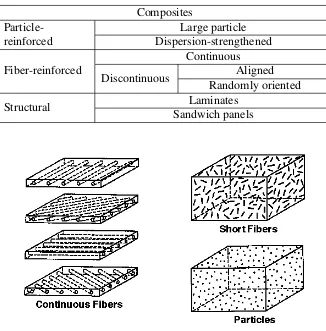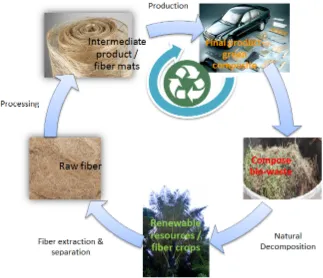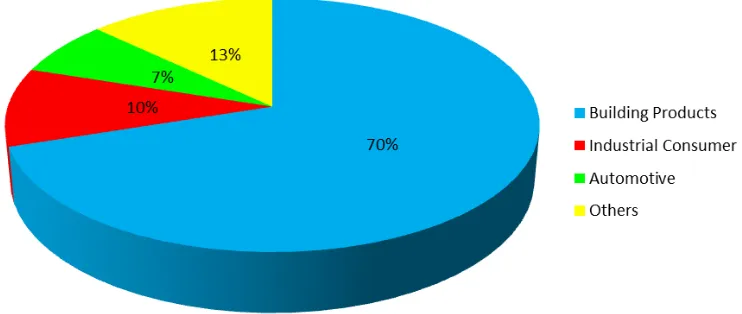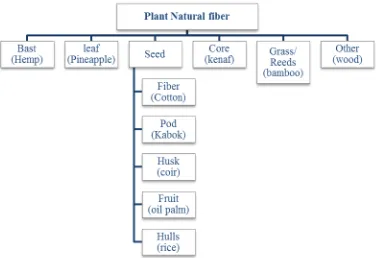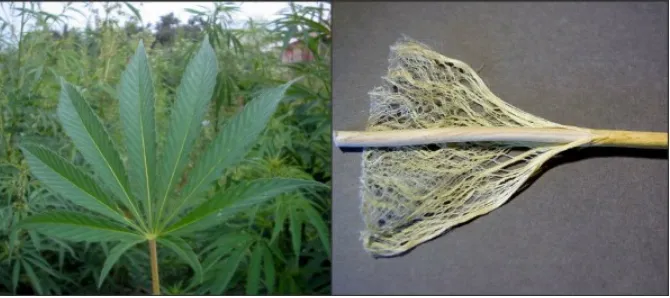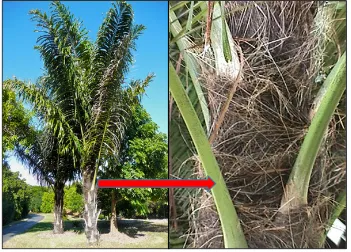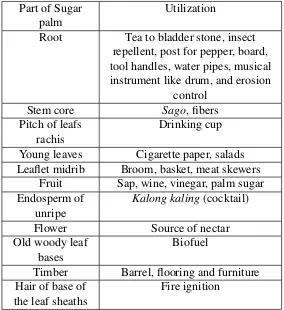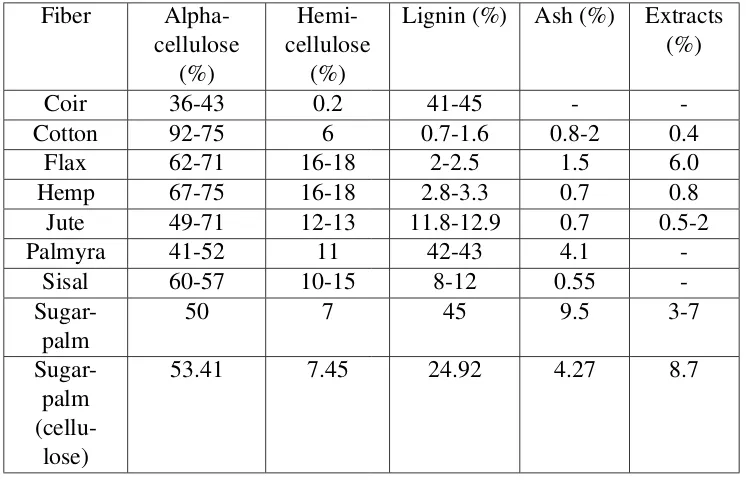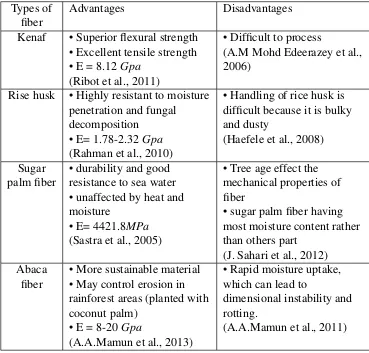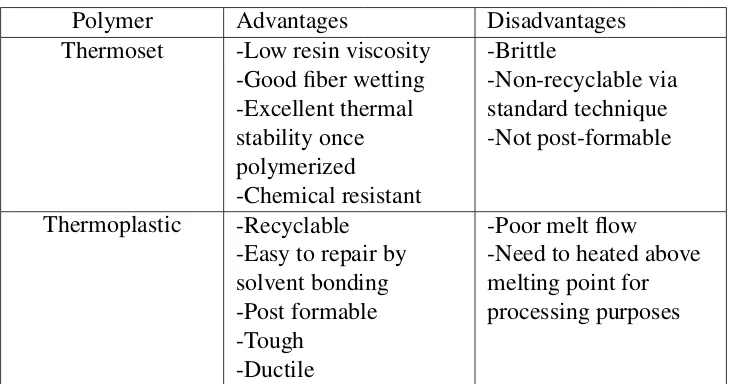THE EFFECT OF SURFACE TREATMENT ON COMPOSITE INTERFACE, TENSILE PROPERTIES AND WATER ABSORPTION OF SUGAR PALM
FIBER/POLYPROPYLENE COMPOSITES
WAN ZUBAIDIE BIN WAN ZAHARI
A thesis submitted in
fulfillment of the requirement for the award of the Degree of Master of Mechanical Engineering
Faculty of Mechanical and Manufacturing Engineering Universiti Tun Hussein Onn Malaysia
Dedicated specially to my parents and siblings;
Wan Zahari & Wan Zainab, Zulhusmie, Zainal Asri, Athirah and Aqilah To my special friends;
Ahmad Fuad and Ahmad Afifi To my supervisors;
Dr Izzuddin Zaman, Dr Denni Kurniawan and Dr fethma Md Nor And all those who have been a great help in the completion of this thesis
My love to all of you will remain forever. . .
ACKNOWLEDGMENT
All the Praises and Thanks to Allah SWT and may peace be upon Prophet Muhammad SAW, the messenger of Allah. With blessing and generosity from Allah SWT, finally I have the strength to complete this research successfully. I would like to express my most sincere gratitude to my supervisor, Dr. Izzuddin Zaman who has provided considerable invaluable insights, guidance and advice, and without any hesitate help me to enhance the quality of my work. His intelligence and determination have been a source of inspiration, and his demands for quality and perfection give me a challenge in order to accomplish my project. In addition, I would like to express my appreciation to my co-supervisor, Dr. Denni Kurniawan who has helped and guided me in this study. His knowledge and advice help me complete my thesis.
Special thanks dedicated to all laboratory staff for their willingness to assist me during the experiment session. Not to forget, special thanks to Prof. Byung Sung Kim, Prof. Jung Il Song and Korea Institute of Materials Science for helping me through the research.
Not to forget to my beloved parent, Hj Wan Zahari Hj Samat and Hjh Wan Zainab Hj Wan Nawan, for their endless support and encouragement through out my study. To all my siblings and others family members too that give a moral support during my study.
Finally, I dedicate this thesis to my beloved friends especially my research group members for their encouragement, support and never lose hope in sending me a prayers for the success.
Wan Zubaidie Bin Wan Zahari, Kota Bharu, Kelantan
ABSTRACT
The rising concern towards environmental issues besides the requirement for more flexible polymer-based material has led to increasing of interest in studying about green composite. Sugar palm fiber (SPF) is a versatile fiber plant employed with wide range of application such as in automotive, packaging and buildings construction. This research was aimed to study the effect of surface treatment on composite interface, tensile properties and water absorption of sugar palm fiber/polypropylene (SPFPP) composite by using different surface treatments such as silane (Si), atmospheric glow discharge plasma (Agd) and maleic anhydride (Ma). Silane treatment was carried out by using immersion method, the Agd plasma was conducted using polymerization and lastly polypropylene grafted maleic anhydride by using melting approach. The SPFPP composite was prepared by using injection moulding with fiber content var-ied from 10–30wt%. The effect of interface enhancement on morphology, mechanical properties and water uptakes of SPFPP composites were then investigated by using FTIR, FESEM, tensile test and water absorption test. Overall, the outcome shows that all types of surface treatments had improved the interface of SPFPP composite, thus improving its tensile properties compared to the benchmark untreated SPFPP (Ut-SPFPP) composites and polypropylene. The 30wt% Ma-SPFPP composite shows the highest improvement in tensile properties with 58% and 27% increase in the respective Young’s Modulus and tensile strength value compared to Ut-SPFPP composite, while 10wt% Ma-SPFPP composite shows the smallest reduction in elongation compared to Neat PP. On the other hand, the 30wt% Si-SPFPP composite shows the lowest water absorption with 20% reduction respective to Ut-SPFPP composite. In conclusion, the surface treatments have proven succesfull in enhancing the natural fiber-polymer in-terface and improve the tensile properties of SPFPP composite with Ma-SPFPP shows the highest improvement, followed by Agd-SPFPP and Si-SPFPP composites.
ABSTRAK
Peningkatan kebimbangan terhadap isu-isu berkaitan dengan alam sekitar disamping permintaan terhadap bahan polimer yang lebih fleksibel telah membawa kepada pen-ingkatan minat dalam mengkaji komposit ‘hijau’ (mesra alam). Gentian gula kabung merupakan gentian tumbuhan yang serba boleh dengan kepelbagaian aplikasi kegu-naan seperti dalam automotif, pembungkusan dan bikegu-naan bangunan. Kajian ini men-sasarkan pemahaman mengenai kesan rawatan permukaan ke atas perhubungan per-mukaan komposit, ciri-ciri tegangan (mekanikal) dan serapan air bagi komposit gen-tian gula kabung dan polimer polypropylene (SPFPP) dengan menggunakan rawatan permukaan seperti rawatansilane(Si), pempolimeran plasma pelepasan cahaya atmos-fera (Agd) dan rawatan maleic anhydride (Ma). Rawatan silane dijalankan melalui kaedah rendaman, sementara rawatan Agd menggunakan kaedah pempolimeran, dan akhir sekali pencantumanmaleic anhydridedenganpolypropylenemelalui pendekatan kaedah pencairan. Komposit SPFPP disediakan dengan kaedah suntikan acuan bersama kandungan gentian bermula dari 10-30wt%. Kesan penambahbaikan perhubungan per-mukaan komposit ke atas morfologi, ciri-ciri tegangan dan kadar resapan air pada kom-posit SPFPP dikaji menggunakan FTIR, FESEM,ujian ketegangan dan ujian penyer-apan air. Secara keseluruhannya, hasil menunjukkan bahawa kesemua rawatan per-mukaan telah menambah baik perhubungan perper-mukaan komposit bagi komposit SPFPP, sekaligus meningkatkan ciri-ciri mekanikal berbanding komposit rujukan iaitu SPFPP komposit tidak terawat (Ut-SPFPP) danpolypropylene. Komposit 30wt% Ma-SPFPP menunjukkan penambahbaikkan paling tinggi dengan peningkatan ciri-ciri tegangan sebanyak 58% dalam modulus keanjalan dan 27% peningkatan dalam nilai kekuatan tegangan berbanding komposit Ut-SPFPP, manakala komposit 10wt% Ma-SPFPP me-nunjukkan perbezaan pengurangan paling kecil dalam nilai pemanjangan berbanding neat polypropylene. Sementara itu, komposit 30wt% Si-SPFPP menunjukkan kadar resapan air paling kurang dengan pengurangan sebanyak 20% berbanding komposit Ut-SPFPP. Kesimpulannya, rawatan permukaan telah berjaya membuktikan penam-bahbaikan ke atas perhubungan permukaan bahan semula jadi dengan polimer serta meningkatkan ciri-ciri tegangan komposit SPFPP dimana komposit Ma-SPFPP me-nunjukkan peningkatan yang paling tinggi, diikuti oleh Agd-SPFPP dan Si-SPFPP.
CONTENTS
DECLARATION ii
DEDICATION iii
ACKNOWLEDGMENT iv
ABSTRACT v
ABSTRAK vi
LIST OF FIGURES x
LIST OF TABLES xii
LIST OF APPENDICES xiii
LIST OF SYMBOLS AND ABBREVIATIONS xiv
CHAPTER 1 INTRODUCTION 1
1.1 Research Background 1
1.2 Problem Statement 4
1.3 Objectives of Study 5
1.4 Scopes of Study 5
1.5 Significant of Study 6
1.6 Thesis Outline 7
CHAPTER 2 LITERATURE REVIEW 8
2.1 Composite 8
2.2 Natural Fiber 10
2.2.1 Fibrous plants reinforcement 13
2.2.2 Bast fiber 14
2.2.3 Sugar palm tree 15
2.2.4 Sugar palm fiber 16
2.3 Polymer Matrix 18
2.3.1 Polypropylene 20
2.4 Potential Applications of Natural Fiber/PP Composite 20
2.5 Constituents Characteristic 21
2.6 Surface Treatment 23
2.6.1 Chemical surface treatment 23
2.6.2 Physical surface treatment 29
2.7 Effect of Surface Treatment on Tensile Properties and
Wa-ter Absorption 30
2.7.1 Summary of research gaps 36
CHAPTER 3 RESEARCH METHODOLOGY 39
3.1 Introduction 39
3.2 Materials Preparation 42
3.3 Instrumentations 43
3.4 Preparation of Surface Modification 48
3.4.1 Silane treatment 48
3.4.2 Atmospheric pressure glow discharge 49 3.4.3 Maleic anhydride grafted polypropylene 52
3.5 Composite Fabrication 53
3.6 Injection Process 55
3.7 Characterization of Composites 55
3.7.1 Material characterization 56
3.7.2 Tensile properties characterization 56 3.7.3 Surface morphology characterization 58
3.7.4 Water absorption 59
CHAPTER 4 RESULTS AND DISCUSSIONS 61
4.1 Material Structure Composition 61
4.2 Tensile Properties of SPFPP Composites 65
4.2.1 Young’s modulus 67
4.2.2 Tensile strength 69
4.2.3 Elongation at break 71
4.3 Surface Morphology of SPFPP Composite 72
4.3.1 Fiber pulling behaviour 73
4.3.2 Cross-sectional of SPFPP composite 76 4.4 Water Absorption Behaviour of Composite 78 4.5 Relationship between Surface Morphology, Tensile
Prop-erties and Water Absorption 81
CHAPTER 5 CONCLUSIONS AND RECOMMENDATIONS 83
5.1 Conclusion 83
5.2 Recommendations 85
REFERENCES 87
LIST OF FIGURES
FIGURE NO TITLE PAGE
2.1 Composites arrangement 10
2.2 Green composite concept 11
2.3 Percentage of natural fiber in plastic composite 12
2.4 Application of natural fiber composite 13
2.5 Classification of plant natural fiber 13
2.6 Hemp plant and bast fiber 14
2.7 Sugar palm tree and sugar palm fiber 15
2.8 Potential application of natural fiber / PP polymer composite 21 2.9 ’Hydrophilic’ vs. ’Hydrophobic’ contact angle 22
2.10 Surface treatment 23
2.11 Interaction of silane 26
2.12 MAPP grafting 28
2.13 Effect of fiber treatment on tensile strength of natural fiber
com-posite 28
3.1 Research flow chart 40
3.2 Materials 42
3.3 Surface Treatment Chemicals 43
3.4 Atmospheric glow discharge plasma chamber 45
3.5 Brabender plastograph mixer 45
3.6 Hot roll mill mixer 46
3.7 Plastic granular 46
3.8 Vacuum oven 47
3.9 Horizontal screw type injection 47
3.10 Auto fine coater machine 47
3.11 Field Emission Scanning Electron Microscope 48
3.12 Silane treatment process 49
3.13 Schematic of atmospheric glow discharge plasma system 50
3.14 Flow process of Agd plasma polymerization 51
3.15 Ma-PP mixing process 52
3.16 Composite pallet fabrication process 54
3.17 Injection process 55
3.18 Tensile test specimen dimension 57
3.19 Tensile test process 58
3.20 Water absorption testing process 60
4.1 FTIR spectra of SPFPP composite treated with silane treatment 62 4.2 Reaction of grafted vinyltrimethoxy silane with SPFPP 62 4.3 FTIR spectra of SPFPP composites treated with AGD plasma 63 4.4 FTIR spectra of SPFPP composites treated with maleic anhydride 64 4.5 Reaction of grafted Ma-PP with SPFPP composite 64
4.6 SPFPP composite sample 65
4.7 Stress-strain curve of SPFPP composite 66
4.8 Young’s modulus of neat PP and SPFPP composite 68
4.9 Tensile strength of neat PP and SPFPP 69
4.10 Elongation at break of neat PP and SPFPP composite 72 4.11 FESEM images of tensile fracture of Ut-SPFPP composite 73 4.12 FESEM images of tensile fracture of Si-SPFPP composite 74 4.13 FESEM images of tensile fracture Agd-SPFPP composite 75 4.14 FESEM images of tensile fracture of Ma-SPFPP composite 75
4.15 Cross-section view of Ut-SPFPP composite 76
4.16 Cross-section view of Si-SPFPP composite 76
4.17 Cross-section view of Agd-SPFPP composite 77
4.18 Cross-section view of Ma-SPFPP composite 78
4.19 Water absorption of SPFPP composite via fiber loading and
sur-face treatments 79
LIST OF TABLES
TABLE NO TITLE PAGE
2.1 Types of composites 10
2.2 Classification of natural fiber 11
2.3 Uses of Arenga pinnata parts 16
2.4 Chemical composition of vegetable fiber 17
2.5 Physical-mechanical of natural fiber 18
2.6 Advantages and disadvantages of different natural fiber 18
2.7 Polymeric matrix 19
2.8 Chemical treatment on natural fiber 24
2.9 Comparison between surface treatment on matrix of composites 25 2.10 Silane treatments structure and functionality 26
2.11 Effect of silane treatment on coir fiber 27
2.12 Types of plasma treatment 30
2.13 Related previous studies 31
3.1 Surface treatment on fiber reinforcement and polymer matrix 41
3.2 Classification of specimens 41
3.3 Instrumentations 43
3.4 Sugar palm fiber/PP composite specimen geometry 57
4.1 Summary of Tensile Properties 67
LIST OF APPENDICES
APPENDIX TITLE PAGE
A FTIR Data 95
B Tensile Test Data 100
C FESEM Image Analysis 103
D Water Absorption Result 112
E List of Publications 117
F Appreciations 118
LIST OF SYMBOLS AND ABBREVIATIONS
%T Percentage of transmittance wt% Weight percentage
Mt% Percentage of water absorption Wf Final weight
Wo Original weight
Agd Atmospheric glow discharge plasma
ASTM American Society of the International Association for Testing and Materials FESEM Field emission scanning electron microscope
FTIR Fourier transform infrared spectroscopy Ma Maleic anhydride
PP Polypropylene
Si Vinyltrimethoxy silane SPF Sugar palm fiber
SPFPP Sugar palm fiber/polypropylene
CHAPTER 1
INTRODUCTION
This chapter introduces research background, including problem statement, hypothesis and the significant of knowledge derived herein. It highlights aims of the project in the context of knowledge gaps identified in this field. The chapter ends with organization of the whole thesis and a brief description for each chapter.
1.1 Research Background
In this modern world, the excitement works on natural fibers as reinforcement in poly-mer composite are triggered by modern vision on green technology. The term green technology, eco-friendly and sustainability are used to refer to the materials that give lower environmental impact in producing the products. The concept contains five im-portant elements which are renewing (product and resource), recycling design, reduc-ing resource, rethinkreduc-ing (overall product), and responsibility towards environments and others (Bachtiar et al., 2009; Ashori, 2008; Azwa et al., 2013; Baillie, 2005). These concerns have led the interest to use green composite which filled with natural organic fillers rather than common synthetic material. Besides, the availability of natural fiber in large amount, lowered market price and its degradation behaviour are able to ben-efit composite instantly such as low density, less machining process and low hazards towards health, in which contrast to glass fiber that hazardous on health, brittle and costly (Owen, 2014). One of the potential natural fibers that is extensively explored and researched recently is sugar palm fiber.
2 Sugar palm fiber which commonly known as ijuk fiber (Arenga pinnata), is the dark fibrous bark of sugar palm tree. For so many years, the fibers have been around for making various of product such as roof top, rope and brush (Aliet al., 2010; Azman, 2013; Bachtiaret al., 2008; Ishaket al., 2012, 2013; Mogeaet al., 1991; Ticoaluet al., 2014). It is well known that sugar palm fiber has their advantages in tensile strength properties and can withstand longer life of degradation, which is less effected by heat and moisture compared to coir fiber; besides durable and having good resistance to sea water (Ishaket al., 2012). By having this unique properties, sugar palm a suitable material for making product that is water resistance such as rope, brooms, or used as filters to clear the water (Mogeaet al., 1991). As for composite application, sugar palm fiber is still an unfamiliar used natural fiber as potential green fiber filler.
Among the polymer material, the polypropylene (PP) is a type of thermoplastic that has been applied in various composite applications as a binder and matrix (Kabir et al., 2012). By having good characteristics such as recyclable, formable and ductile, PP-based composites have been used extensively in packaging, manufacturing, and piping system. Polypropylene is in many aspects similar to polyethylene, especially in solution behaviour and electrical properties. The properties of polypropylene are depending on the molecular weight and molecular weight distribution, crystallinity, type and proportion of co-monomer and the isotacticity (Painteret al., 1977).
Basically, PP polymer and natural fiber filler are not compatible to form as great composite. In order to enhance the compatibility between natural fibrous filler and matrix of PP, coupling agents which refer to surface treatments have been used. Previously, there are several surface treatments that were employed to improve the comparability of natural fiber (Li et al., 2007). The surface treatment is divided into three types which are: (i) chemical surface treatment, (ii) physical surface treatment and (iii) physic-chemical surface treatment (Fuqua et al., 2012). These treatments either can be carried out on the reinforcement filler or even the matrix of the composites in order to improve the surface contact.
increas-3 ing the interfacial strength. It was verified that the interaction between silane coupling agent modified fiber and matrix was much stronger than alkaline treatment, thus led to composites with higher tensile strength (Redzuan, 2012).
Other types of surface treatment that usually applied on the fiber type filler is plasma polymerization. By focusing on the physical treatment, plasma sources are used to generate a discharge gas that provide energy to activate liquid monomer, con-tains a vinyl group, for initiating polymerization. The fibrous filler produced from this technique is generally a highly branched and cross-linked (Kurniawan et al., 2012). The biggest advantage of this process is that filler reinforcement can be directly at-tached to a desired surface while the chains are growing which reduces step necessary for other coating process such as grafting. This is very useful for coatings of 100 picometers to 1 micrometers thickness (Haet al., 2011).
In the previous study by El-Sabbagh (2014) stated that a lot of method was em-ployed to enhance the adhesion between matrix and reinforcement including physical treatment and chemical treatment. As for matrix surface treatment, maleic anhydride (Ma) is a common coupling agent that providing efficient interaction on functional be-tween matrix and surface of fiber (Canteroet al., 2003). The Ma grafted to PP known as treated polymer is a well-known treatment used to enhance the interfacial for poly-mer matrix. During the grafting process, Ma reacts with hydroxyl group in fiber while PP co-crystallizes with unmodified fiber and form the bridge between fiber and treated PP (Liet al., 2007). In this experiment, the weight percentage instead of volume per-centage is applied since it is the most common equation used in the calculation of fiber weight during mixing with polymer matrix. According to Gibeop et al. (2013) and Kurniawanet al.(2013), the reinforcement fibers cannot being determined by volume fraction due to a large error of volume determination from hydrostatic methods. Thus, the detail research on mechanical and chemical properties of sugar palm fiber were suggested in recommendation section.
4
1.2 Problem Statement
Nowadays, the application of composites play an important parts as substitution ma-terials for others in various fields of application such as construction and automotive. However, the dependencies towards synthetic fibers, for example fiber glass is not enough, in addition of disadvantages of these fiber which highly in cost, hazardous material and non-renewable materials (Ashori, 2008; Azwaet al., 2013; Furqanet al., 2015). Therefore, natural fiber reinforcement is suitable replacement for synthetic fiber in composite application. The fibers are emerging as low-cost, light weight, recyclable and eco-friendly material with low density and renewable resources (Baillie, 2005).
In spite of these advantages, most of natural fibers has a tendency to form ag-gregates during process due to poor heat resistance and low moisture resistance (Sahari et al., 2012; Ticoaluet al., 2014). As the alternative, sugar palm fiber, which is good in heat and moisture resistant, can be consided as a potential natural fiber for rein-forcement in composite based polymer. In addition to research study, sugar palm fiber is still considered new and much to be explored as reinforcement in polymer based composite.
As for polymer, the thermoplastic material is consider as the best option in term of “green technology” due to five elements concept which prefer the recyclable material rather than thermoset material (Azwa et al., 2013; Bavan & Kumar, 2011; Coutinho & Costa, 1999). Nevertheless, the thermoplastic typically performed poorly in long-term loading because linear polymer molecule exhibit strong time and temper-ature dependent response. Of thermoplastic, Polypropylene (PP) is a low cost indus-trial material, light weight, recyclable, eco-friendly and easy to process (Baillie, 2005; Coutinho & Costa, 1999). Besides, the properties have district features depending upon cellulose content which varies from fiber to fiber.
com-5 posites lack being exposed to various surface treatments and commonly being treated only with alkaline treatment (Bachtiaret al., 2008, 2009).
Lastly, being the natural fiber composites had reduced the individual character-istic of material such as mechanical and physical properties. Thus, the green compos-ites cannot achieve higher mechanical properties as synthetic composcompos-ites such as fiber glass. Due to these, the use of natural fiber or green composite as the replacement to synthetic fiber composites seems doable by improving the structure and interface of natural fiber (Fuquaet al., 2012; Furqan et al., 2015; La Mantia & Morreale, 2011). As physical properties, the characteristics of natural fiber that tend to absorb and con-tain the moisture lead to disadvantages of composite. Therefore, the characteristic of composite must be improvized to overcome the deficiency (Kabiret al., 2012; Liet al., 2007; Xieet al., 2010).
1.3 Objectives of Study
In order to address the above aforementioned problems, the objectives of the study are to be designed as follows:
i. To determine the effect of different surface treatments such as silane, atmo-spheric glow discharge polymerization and maleic anhydride on the interface and tensile properties of sugar palm fiber/polypropylene composite.
ii. To minimize the water absorption of sugar palm fiber/polypropylene composites by treated with surface treatments.
iii. To determine the surface morphology-tensile properties-water absorption rela-tionships of sugar palm fiber/polypropylene composites.
1.4 Scopes of Study
6 for Agd, and melting method for Ma and PP. The untreated sugar palm fiber was pre-pared by cutting the raw SPF in required sizes and immersed in distil water to remove dirt and other substance. The cut-off size for sugar palm fiber was 2 mm with the weight percentages of sugar palm fiber used in composites were 10, 20 and 30wt% (both treated and untreated samples). In order to characterize the effect of surface treatment on SPFPP composite, Fourier Transform Infrared spectroscopy (FTIR) was employed for material structure evaluation, while tensile test refer to ASTM D 638 for tensile properties, field emission scanning electron microscope (FESEM) for morphol-ogy structure and fiber pull-out behaviour analysis, and finally water absorption test was performed for physical properties evaluation. Five specimens were averaged for tensile test and water absorption, while three sample used for FESEM.
1.5 Significant of Study
Recently, the use of natural fiber composites compared to synthetic fiber composites are extensively researched due to harmful and disadvantages aspect of synthetic fiber. Thus, “green” technology natural fiber composite now have been common adaptation in many field of work such automotive, industrial manufacturing or even in building construction. As for sugar palm fiber, its natural resource that plenty in local area, reasonable in price with addition of good mechanical properties has created its full potentials as new “green” fiber composite to be developed. To improve the mechanical properties of natural fiber composite, several surface treatments are being introduced, either chemical surface treatment or physical surface treatment.
The surface treatment such as silane treatment and AGD polymerization change the characteristic of fiber, enhance the interface with the matrix and improves the ten-sile properties of composites. The treatment also reduces the water absorption of the composite by changing hydrophilic characteristic of the reinforcement. On the other word, the treatments increase the surface of fiber and modified the characteristic which allow more surface contact with the matrix and enhance the interface; thus improving the mechanical properties of composite.
7 the enhancement of interface and improvement in mechanical properties of the natural fiber composites can create more opportunity for the replacement of synthetic fiber such as fiber glass.
Several contributions are also presented in the research study such as: (i) var-ious of possible treatment to enhance the interface and its posibility to improve the tensile properties of green composites, (ii) various of significant testing to identify the enhancement of interface strength and tensile properties of composites, and (iii) guidelines for preparation of optimum surface treatment of green composites.
1.6 Thesis Outline
This thesis is organized into five chapters. A brief outline of the thesis contents is as follows:
• Chapter 1 presents general information about overall research study. It involves the research background, problem statement, objective, scope and significant of study well as the hypothesis of study.
• Chapter 2 focuses on a fundamental theory of the composites, “green” compos-ites, understanding of natural fiber composcompos-ites, and different surface treatment done on composites component. Apart of that, previous study related to this research in particular the improvement of the mechanical properties of natural fiber composites were also presented in the chapter.
• Chapter 3 describes the specification of materials and surface treatments used in the research. This chapter serves the research methodology carried out in this study, including the used instrumentation, step by step procedure of composite specimens’ fabrication, procedure of composites testing.
• Chapter 4 begins by laying out the results and an in-depth discussion of modifica-tion sugar palm fiber/polypropylene composites (SPFPP), material characteriza-tion analysis, tensile properties, water absorpcharacteriza-tion, and also surface morphology of composites.
CHAPTER 2
LITERATURE REVIEW
This chapter provides readers with a general review on the theory of composite, “green” composites, understanding of natural fiber composites, and surface treatments. It also covers details on reinforcement and matrix of the composite used in this study. The last part of this section reviews previous surface treatment and its surface target, as well as the knowledge of its mechanical properties. This section aims to acquire important in-formation related to the area of study, in order to give more idea and identified research gaps before the project is implemented. All information was gathered mostly from the text books, journals and internet.
2.1 Composite
The composite can be defined as combination of material either two or more materi-als with significantly different physical or chemical properties, produced new material with characteristics that different from individual components and give unique prop-erties. The main material is the matrix or binder of the composites, which purposely surrounds and binds together fragments of the other materials, called as the reinforce-ment. The reinforcements impart their special mechanical and physical properties to enhance the matrix properties (Baillie, 2005). A synergism produces material prop-erties unavailable from the individual constituent materials, while the wide variety of matrix and strengthening materials allows the designer of the product or structure to choose an optimum combination (La Mantia & Morreale, 2011).
The first modern composite material was made from fiberglass and plastic, which is still widely used for various of product that need precise tolerance, supe-rior strength to weight ratio, corrosion resistance and durable in time besides having good in mechanical properties (Ashori, 2008). On its own, the glass is very strong
9 but brittle and it will break if bent sharply. The plastic matrix holds the glass fibers together and also protects them from damage by sharing out the forces acting on them. Some advanced composites are now made using carbon fibers instead of glass, which are lighter and stronger than fiberglass but more expensive to produce (Baillie, 2005; Bavan & Kumar, 2011). A composites also can be classified based on the reinforce-ment for the example particulate composite, flake composite, random fiber composite, continuous fiber laminar composite, woven laminar composite and braided composite (Wambuaet al., 2003).
The development of new composites and its application is now accelerating, thus the future application of composites will be limited only by the lack of ingenu-ity and unwillingness of individual and the society to explore. Since new ideology in technology, the word “Green” play a new role in producing new phase of early com-posites to new era comparable with advance comcom-posites. Green comcom-posites which also known as bio-composites or natural composites are the term used for new studies of early composites; mostly from nature such animal, plant and mud (Baillie, 2005).
There are different types of composites that have been studied in Table 2.1. Typical engineered composite materials include:
• Composite building materials such as cement, concrete. • Reinforced plastics, such as fiber-reinforced polymer. • Metal composites.
• Ceramic composites (composite ceramic and metal matrices).
10 Table 2.1: Types of composites
Composites
Particle-reinforced
Large particle Dispersion-strengthened Fiber-reinforced
Continuous
Discontinuous Aligned
Randomly oriented
Structural Laminates
[image:23.595.149.489.93.209.2]Sandwich panels
Figure 2.1: Composites arrangement (Ashori, 2008)
2.2 Natural Fiber
11
Figure 2.2: Green composite concept
[image:24.595.132.508.546.671.2]For natural fibers, they are less homogeneous than glass or carbon, tend to ab-sorb moisture, and are less compatible with conventional resin systems (Ashori, 2008). Pre-processing and treatment are thus required to enhance the performance of the com-posite solution. Generally, natural fiber can be found naturally on many places on earth and can be classified into several types based on their physical form and background as shown in Table 2.2.
Table 2.2: Classification of natural fiber (Haet al., 2011) NATURAL FIBER
Vegetable / Plant
Seed Fiber Cotton, Kapok, Risk husk Bast Fiber Flex, Hemp, Jute, Kenaf, Ramie Leaf Fiber Sisal, Pineapple, Abaca
Animal Wool Agrora, Hair
Silk
Mineral Asbestos
12 Natural fiber is simply defined as fibrous plant material produced as a result of photosynthesis (Azwa et al., 2013; Baillie, 2005; Cheunget al., 2009). These fibers are sometimes being referred as vegetable, biomass, photomass, solarmass or photo-synthetic fibers. The general term used is lignocellulosic fibers, however, the term meaning ‘lignin and cellulose containing’ where some fiber might only have few or no lignin (Eichhornet al., 2001).
The use of natural fiber started back in history about 8000 BC, which fiber of date, ramie even papyrus play important part during Egypt period, and being noticed as the starter of the early composites during that times. Grass and straw have been used as reinforcing fiber in mud block (adobe) and pharaoh mummies were wrapped in linen cloth impregnated with salt, resins and honey to reinforce them, proven the early composite fabrication (Baillie, 2005).
[image:25.595.136.507.520.677.2]As nowadays, the dependence on renewable resources growing intensely result-ing from the awareness about non-renewable resources that becomresult-ing scarce. The 21st century may be the cellulosic century as research look more and more to renewable plant resources for manufacturing (Pickering, 2008). Thus, the uses of fiber-reinforced polymer composite as the replacement in various fields of application become pop-ular. The natural fiber thermoplastic composite as example shows the increased de-mand years by years since 2000. It has been major markets for natural fiber in plastic composites, as Figure 2.3, on weight basic (Monteiro et al., 2010). The were several application of natural composite being used as displayed in Figure 2.4.
13
Figure 2.4: Application of natural fiber composite; a) Interior automotive parts, b) Cas-ing, and c) Roof panel (Monteiroet al., 2010)
2.2.1 Fibrous plants reinforcement
In term of utilization, there are two general classifications of plants producing natural fibers, which is primary and secondary. The primary plant are those grown for their fiber content such jute, hemp, sisal and cotton, while the secondary are those where the fiber come as by-product from other primary utilization such palm oil, pineapple, stalk and husk. The common classification for natural fiber is by their botanical type. Using this classification, there are six types of natural fibers as shown in Figure 2.5. As sugar palm fiber, its been consider as secondary plant which the fiber come as by-product from other utilization and being classified as bast fiber.
[image:26.595.142.518.455.713.2]14
2.2.2 Bast fiber
Bast fiber as shown as Figure 2.6 is plant fiber that been collected from the phloem of dicotyledonous plant or "inner bark” sometimes called "skin" which provide structural strength and rigidity to the plant stem. These fibers lay under thin bark and exist as fiber bundles or strands and run parallel to the length of stem. Since the valuable fibers are located in the phloem, they must often be separated from the xylem material, and sometimes also from epidermis. The clear and most common bast fiber is hemp fiber.
[image:27.595.153.488.370.519.2]Hemp is the common name for plant from family ofCannabis. Cannabis sativa L.subsp. sativa var. sativa is the variety grown for industrial fiber in Europe, Canada, China and elsewhere, whileC. sativasubsp. Indicawth poor fiber quality is primarily grown for production of recreational and medicinal drugs. It is consider as oldest cultivated fiber plant in world, grown up to 4.5min height in approximately 140-145 day with stem diameter of 4-20mm(Baillie, 2005).
Figure 2.6: Hemp plant and bast fiber (Baillie, 2005)
15
2.2.3 Sugar palm tree
The sugar palm tree is a member of thePalmae family and naturally a forest species. There has been reported that sugar palm has around 150 local names, indicating its multiple uses by the villagers. These names include Arenga pinnata, Areng palm, black fiber palm, gomuti palm, aren, irok, bagot, and kaong (Ticoalu et al., 2014; Sahariet al., 2012).
[image:28.595.143.494.475.727.2]Sugar palm fiber, which known by local as ijuk fiber, is the fibers produced from a part of sugar palm tree, and one of the oldest cultivated plants in Asia shown in Figure 2.7. Geographically, the palm tree distributed in all of tropical South and South-east Asia countries, basically at humid area from India to Guam and from Myanmar to Nusa Tenggara Timur in Indonesia. Typically, it grows close to human settlements where anthropochoric breeding plays a major role.
Sugar palm is one of the most diverse multipurpose tree species in culture, which had widest range of use involving all part from root to the leaf (Sahari et al., 2012). Table 2.3 shows list the utilization of sugar palm as traditional source of income. The tree usually can reach the height of 15-20 m and 30-40 cm in diameter. The lifespan of this tree around 12 to 20 years and the maturity of tree can be seen from appearance of two short leaves at the top of stem. First flowering of the tree is at 10 to 20 years but it can be early than that like 5 to 6 years (Ishaket al., 2012).
16 Table 2.3: Uses of Arenga pinnata parts (Mogeaet al., 1991; Ticoaluet al., 2014)
Part of Sugar palm
Utilization
Root Tea to bladder stone, insect repellent, post for pepper, board, tool handles, water pipes, musical instrument like drum, and erosion
control
Stem core Sago, fibers
Pitch of leafs rachis
Drinking cup Young leaves Cigarette paper, salads Leaflet midrib Broom, basket, meat skewers
Fruit Sap, wine, vinegar, palm sugar Endosperm of
unripe
Kalong kaling(cocktail)
Flower Source of nectar
Old woody leaf bases
Biofuel
Timber Barrel, flooring and furniture Hair of base of
the leaf sheaths
Fire ignition
2.2.4 Sugar palm fiber
17 Table 2.4: Chemical composition of vegetable fiber (Ticoaluet al., 2014)
Fiber
Alpha-cellulose (%)
Hemi-cellulose
(%)
Lignin (%) Ash (%) Extracts (%)
Coir 36-43 0.2 41-45 -
-Cotton 92-75 6 0.7-1.6 0.8-2 0.4
Flax 62-71 16-18 2-2.5 1.5 6.0
Hemp 67-75 16-18 2.8-3.3 0.7 0.8
Jute 49-71 12-13 11.8-12.9 0.7 0.5-2
Palmyra 41-52 11 42-43 4.1
-Sisal 60-57 10-15 8-12 0.55
- Sugar-palm
50 7 45 9.5 3-7
Sugar-palm
(cellu-lose)
53.41 7.45 24.92 4.27 8.7
18 Table 2.5: Physical-mechanical of natural fiber (Bachtiaret al., 2010)
Natural fiber
Density, g/cm3
Tensile strength, MPa Young modulus, GPa
Strain, % Diameter, µm
Bamboo 0.6-0.8 200.5 - 10.2
-Coir 1.25 138.7 6 10.5 396.98
Hemp 1.48 50-900 73 1.6
-Kenaf 1.4 215.4 13-17 1.18-1.31
-Jute 1.18 393-773 26.5 1.8 200
A. Pinnata 1.29 190.29 3.69 19.6 99-311
*E-glass 2.55 1800-3000 72-83 3 8-14
Table 2.6: Advantages and disadvantages of different natural fiber Types of
fiber
Advantages Disadvantages
Kenaf • Superior flexural strength • Excellent tensile strength • E = 8.12Gpa
(Ribot et al., 2011)
• Difficult to process
(A.M Mohd Edeerazey et al., 2006)
Rise husk • Highly resistant to moisture penetration and fungal decomposition
• E= 1.78-2.32Gpa (Rahman et al., 2010)
• Handling of rice husk is difficult because it is bulky and dusty
(Haefele et al., 2008) Sugar
palm fiber
• durability and good resistance to sea water • unaffected by heat and moisture
• E= 4421.8MPa (Sastra et al., 2005)
• Tree age effect the mechanical properties of fiber
• sugar palm fiber having most moisture content rather than others part
(J. Sahari et al., 2012) Abaca
fiber
• More sustainable material • May control erosion in rainforest areas (planted with coconut palm)
• E = 8-20Gpa
(A.A.Mamun et al., 2013)
• Rapid moisture uptake, which can lead to
dimensional instability and rotting.
(A.A.Mamun et al., 2011)
2.3 Polymer Matrix
[image:31.595.133.502.295.648.2]19 stress to reinforcement, protection from surface damage and acting as barrier to crack propagation. It also can be defined as material that in a bulk and continuous phase that surrounds the reinforcement. A matrix material can be within all the materials classes like polymer, metal and ceramic (Park & Seo, 2011). Each material that been use for matrix has its own advantages as shown in Table 2.7 (Kabiret al., 2012). For this study, polymeric matrices will be used together with natural fiber filler. The thermoplastic materials that currently dominate as matrices for natural fibers are polypropylene and polyethylene, while thermoset, such as phenolics, epoxy and polyesters, are common matrices.
Table 2.7: Polymeric matrix (Kabiret al., 2012)
Polymer Advantages Disadvantages
Thermoset -Low resin viscosity -Good fiber wetting -Excellent thermal stability once polymerized -Chemical resistant -Brittle -Non-recyclable via standard technique -Not post-formable Thermoplastic -Recyclable -Easy to repair by solvent bonding -Post formable -Tough
-Ductile
-Poor melt flow -Need to heated above melting point for processing purposes
20
2.3.1 Polypropylene
Polypropylene (PP), which one of the polymer materials, is monomer unit in terms of molecules that been produced by polymerizing propylene. PP has the chemical formula of C3H6. The polypropylene material known as economical material that offer a combination of outstanding physical, chemical, mechanical, thermal and electrical properties that cannot be found in another thermoplastic materials.
Generally, PP provides excellent resistant to organic solvent, decreasing agent and electrolysis effect. Evan the polymer has lower impact strength, it has superior working temperature and tensile strength. The PP comes with great advantages in properties such as low density, high stiffness, heat resistance, chemical inertness, good transparency, good impact, stretchability, good hinge properties and recyclability. Be-sides that, it also an elastic and formable material which easy to process and high water resistance.
Through the application, the PP were well known in various product which ap-plicable with properties provide by the polymer such as lightweight material, excellent dielectric properties, chemical resistant product, low moisture absorption, non-toxic and easy to fabricate.
Due to these advantages, many industries have chosen PP as their material such as automotive, household goods, electrical application and even the aircraft compart-ment.
2.4 Potential Applications of Natural Fiber/PP Composite
As technology reaching the new era, the application of composite became more attrac-tive and new trend where the replacement for other’s materials (e.g. metal and ceramic) become common and the applications not only focusing on one field only. As for fiber reinforced polymer(FRP) composite, by having fiber such as glass, carbon and aramid which came with great material properties, the FRP composite was commonly used in aerospace, automotive, marine and construction industries (Joshiet al., 2004).
unsus-21 tainable (Fuquaet al., 2012; Wambuaet al., 2003). In term of “green technology”, the thermoplastic polymer was getting more attention rather than thermoset since the char-acteristic of polymer which can be recycle thus implement one of element in “green technology”; recycling design. Therefore, natural fiber polypropylene based compos-ite has highest demand especially in application in automotive (finishing and interior design), building construction (panel), packaging and component with details as illus-trated in Figure 2.8 (Furqanet al., 2015; La Mantia & Morreale, 2011).
[image:34.595.157.478.399.569.2]The demand on natural fiber PP based composite has been increase hence the PP based polymer can be processed into complex shaped component which give clean and smooth finishing to the product. Moreover, the polymer has advantages to produce product that require precision and detail on each aspect of product; finishing product. Therefore, as for natural fiber, the most important parameter was the sizes of fiber which requires to has flexibility during process of composite, thus short fiber has per-form all the condition for the process. Besides that, the short fiber and PP polymer have archived the requirement for standard thermo-plastic injection moulding equip-ment (Ibnabdeljalil & Curtin, 1997; Linet al., 2008; Phoenixet al., 1997).
Figure 2.8: Potential application of natural fiber / PP polymer composite
2.5 Constituents Characteristic
cellu-22 lose fibers (on most of natural fiber) and the hydrophobic property of polymer matrix, which is associated with poor surface properties for association within the polymer matrix, and a degradation of mechanical properties.
[image:35.595.169.474.302.542.2]The word ‘hydro’ comes from Greek meaning the water, while the ‘-philic’, from root of philia can be define as attraction or affinity to something, and the ‘-phobic’, from root of phobia meaning repelled or tendency to aggregate. Thus, the hydrophilic mean the material (refer to natural fiber) are attracted to water and tends to absorb the moisture molecule, as the hydrophobic means the materials (refer to poly-mer) are seemingly repelled from the water and does not absorb the moisture. Fig-ure 2.9 show the differences between hydrophilic and hydrophobic material through the contact angle.
Figure 2.9: ’Hydrophilic’ vs. ’Hydrophobic’ contact angle
23
2.6 Surface Treatment
The surface treatment that can be done on the green composites can be divided into three types which are the surface treatment by using chemical treatment, physical treat-ment and physic-chemical as shown in Figure 2.10. The main disadvantage with using natural fibers as the reinforcement is the week interfacial adhesion between the matrix and the fibers (Fuqua et al., 2012). The hydrophilicity of natural fiber makes weak bonding with hydrophobic material like polymers. Then, the treatment comes handy in helping to modify either matrix or reinforcement surface structure, and make them suitable to having good bonding against each other.
[image:36.595.175.464.396.504.2]By using the treatment, the properties of the composite also be enhance and in-crease compare to untreated composites. The example of chemical technique are silane and alkaline treatment, which basically done on the reinforcement, while MAPP usu-ally used for the matrix treatment. For physical techniques there are corona discharge treatment and solvent extraction, and for the physic-chemical treatment are hydrother-mal treatment and steam explosion.
Figure 2.10: Surface treatment (Fuquaet al., 2012)
In this research study, there were two types of surface treatment being approach with three different mechanisms, which is the chemical surface treatment and physical surface treatment. These treatments were approached both constituents, either sugar palm fiber reinforcement or PP polymer matrix.
2.6.1 Chemical surface treatment
24 order to improve the bonding interface between natural fiber and matrix composites and always had interest in research.
[image:37.595.171.469.279.604.2]The examples of chemical treatment are alkalization, silane and permanganate (Liet al., 2007) as shown in Table 2.8. Besides that, there are several chemical treat-ment can be done for fiber-matrix composites such as acetylation treattreat-ment, benzoyla-tion treatment and the MAPP treatment (Kabir et al., 2012) as tabulated in Table 2.9. For this study, silane treatment and maleic anhydride (MA) treatment being applied to increase the adhesion between matrix and reinforcement, thus enhance the interface of composite.
Table 2.8: Chemical treatment on natural fiber (Liet al., 2007) Treatment Descriptions
Alkaline treatment • Disruption of hydrogen bonding in the network structure, increasing surface roughness.
• removes a certain amount of lignin, wax and oils covering the external surface, depolymerizes cellulose and exposes short length crystallite
Silane treatment • may reduce the number of cellulose hydroxyl groups in the fiber– matrix interface
• hydrocarbon chains restrain the swelling of the fiber by creating a cross-linked network due to covalent bonding
Permanganate treatment
• leads to the formation of cellulose radical through MnO3– ion
formation
REFERENCES
Ali, A., Sanuddin, A. & Ezzeddin, S. (2010). The effect of aging on arenga pinnata fiber-reinforced epoxy composite.Materials & Design, 31(7), pp. 3550–3554. Andic Cakir, o., Sarikanat, M., Tufekci, H.B., Demirci, C. & Erdogan, U.H.
(2014). Physical and mechanical properties of randomly oriented coir fiber– cementitious composites.Composites Part B: Engineering, 61, pp. 49–54. Arbelaiz, A., Fernandez, B., Ramos, J., Retegi, A., Llano-Ponte, R. & Mondragon,
I. (2005). Mechanical properties of short flax fibre bundle/polypropylene com-posites: Influence of matrix/fibre modification, fibre content, water uptake and recycling.Composites Science and Technology, 65(10), pp. 1582–1592. Ashori, A. (2008). Wood–plastic composites as promising green-composites for
auto-motive industries.Bioresource Technology, 99(11), pp. 4661–4667.
Azman, S.S. (2013). Influence of fiber volume fraction and vacuum pressure on flex-ural properties of sugar palm frond fiber reinforced polyester composites. Aus-tralian journal of basic and applied sciences, 7(4), pp. 318–322.
Azwa, Z., Yousif, B., Manalo, A. & Karunasena, W. (2013). A review on the degrad-ability of polymeric composites based on natural fibres.Materials & Design, 47, pp. 424–442.
Bachtiar, D., Sapuan, S. & Hamdan, M. (2009). The influence of alkaline surface fibre treatment on the impact properties of sugar palm fibre-reinforced epoxy com-posites.Polymer-Plastics Technology and Engineering, 48(4), pp. 379–383. Bachtiar, D., Sapuan, S., Zainudin, E.S., Khalina, A. & Dahlan, K. (2010). The
ten-sile properties of single sugar palm (arenga pinnata) fibre. In: IOP Conference Series: Materials Science and Engineering, volume 11, IOP Publishing, p. 012012.
Bachtiar, D., Sapuan, S. & Hamdan, M.M. (2008). The effect of alkaline treatment on
88 tensile properties of sugar palm fibre reinforced epoxy composites. Materials & Design, 29(7), pp. 1285–1290.
Baillie, C. (2005). Green Composites: Polymer Composites and the Environment. Green Composites: Polymer Composites and the Environment, Taylor & Fran-cis, ISBN 9780849325762.
Bavan, S. & Kumar, M. (2011). Conceptual design features and eco-methods. In: ICORD 11: Proceedings of the 3rd International Conference on Research into Design Engineering, Bangalore, India, 10.-12.01. 2011.
Bozaci, E., Sever, K., Demir, A., Seki, Y., Sarikanat, M. & Ozdogan, E. (2009). Effect of the atmospheric plasma treatment parameters on surface and mechanical properties of jute fabric.Fibers and Polymers, 10(6), pp. 781–786.
Cantero, G., Arbelaiz, A., Llano-Ponte, R. & Mondragon, I. (2003). Effects of fibre treatment on wettability and mechanical behaviour of flax/polypropylene com-posites.Composites science and technology, 63(9), pp. 1247–1254.
Chandramohan, D. & Marimuthu, D.K. (2011). Tensile and hardness tests on natural fiber reinforced polymer composite material.
Cheung, H.Y., Ho, M.P., Lau, K.T., Cardona, F. & Hui, D. (2009). Natural fibre-reinforced composites for bioengineering and environmental engineering ap-plications.Composites Part B: Engineering, 40(7), pp. 655–663.
Coutinho, F.M. & Costa, T.H. (1999). Performance of polypropylene–wood fiber com-posites.Polymer Testing, 18(8), pp. 581–587.
Demir, H., Atikler, U., Balköse, D. & Tıhmınlıo˘glu, F. (2006). The effect of fiber sur-face treatments on the tensile and water sorption properties of polypropylene– luffa fiber composites. Composites Part A: Applied Science and Manufactur-ing, 37(3), pp. 447–456.
Eichhorn, S., Baillie, C., Zafeiropoulos, N., Mwaikambo, L., Ansell, M., Dufresne, A., Entwistle, K., Herrera-Franco, P., Escamilla, G., Groom, L. et al.(2001). Review: current international research into cellulosic fibres and composites. Journal of materials Science, 36(9), pp. 2107–2131.
fi-89 bre/polypropylene composites on mechanical and thermal behaviour. Compos-ites Part B: Engineering, 57, pp. 126–135.
Fuqua, M.A., Huo, S. & Ulven, C.A. (2012). Natural fiber reinforced composites. Polymer Reviews, 52(3), pp. 259–320.
Furqan, A., Choi, H.S. & Park, M.K. (2015). A review: Natural fiber composites selec-tion in view of mechanical, light weight, and economic properties.Macromol. Mater. Eng., 300, pp. 10–24.
Gao, H., Xie, Y., Ou, R. & Wang, Q. (2012). Grafting effects of polypropy-lene/polyethylene blends with maleic anhydride on the properties of the result-ing wood–plastic composites.Composites Part A: Applied Science and Manu-facturing, 43(1), pp. 150–157.
Gibeop, N., Lee, D., Prasad, C.V., Toru, F., Kim, B.S. & Song, J.I. (2013). Effect of plasma treatment on mechanical properties of jute fiber/poly (lactic acid) biodegradable composites. Advanced Composite Materials, 22(6), pp. 389– 399.
Ha, J., Kurniawan, D., Kim, B. & Song, J. (2011). Mechanical properties of plasma polymerized cellulose fabric/polylactic acid. Korean Soc. Compos. Mater, 2, pp. 29–31.
Herrera-Franco, P. & Valadez-Gonzalez, A. (2005). A study of the mechanical proper-ties of short natural-fiber reinforced composites.Composites Part B: Engineer-ing, 36(8), pp. 597–608.
Ibnabdeljalil, M. & Curtin, W. (1997). Strength and reliability of fiber-reinforced com-posites: localized load-sharing and associated size effects.International Jour-nal of Solids and Structures, 34(21), pp. 2649–2668.
Ichazo, M., Albano, C., Gonzalez, J., Perera, R. & Candal, M. (2001). Polypropy-lene/wood flour composites: treatments and properties.Composite structures, 54(2), pp. 207–214.
Ishak, M., Sapuan, S., Leman, Z., Rahman, M. & Anwar, U. (2012). Characteriza-tion of sugar palm (arenga pinnata) fibres. Journal of thermal analysis and calorimetry, 109(2), pp. 981–989.
90 Sugar palm (arenga pinnata): Its fibres, polymers and composites. Carbohy-drate polymers, 91(2), pp. 699–710.
Izani, M.N., Paridah, M., Anwar, U., Nor, M.M. & Hng, P. (2013). Effects of fiber treatment on morphology, tensile and thermogravimetric analysis of oil palm empty fruit bunches fibers.Composites Part B: Engineering, 45(1), pp. 1251– 1257.
Joshi, S.V., Drzal, L., Mohanty, A. & Arora, S. (2004). Are natural fiber composites en-vironmentally superior to glass fiber reinforced composites? Composites Part A: Applied science and manufacturing, 35(3), pp. 371–376.
Kabir, M., Wang, H., Lau, K. & Cardona, F. (2012). Chemical treatments on plant-based natural fibre reinforced polymer composites: An overview. Composites Part B: Engineering, 43(7), pp. 2883–2892.
Kafi, A.A., Magniez, K. & Fox, B.L. (2011). A surface-property relationship of atmo-spheric plasma treated jute composites. Composites science and technology, 71(15), pp. 1692–1698.
Keener, T., Stuart, R. & Brown, T. (2004). Maleated coupling agents for natural fibre composites.Composites part A: applied science and manufacturing, 35(3), pp. 357–362.
Khalid, M., Ali, S., Abdullah, L., Ratnam, C. & Choong, S.T. (2006). Effect of mapp as coupling agent on the mechanical properties of palm fiber empty fruit bunch and cellulose polypropylene biocomposites.International Journal of Engineer-ing and Technology, 3(1), pp. 79–84.
Ku, H., Wang, H., Pattarachaiyakoop, N. & Trada, M. (2011). A review on the tensile properties of natural fiber reinforced polymer composites.Composites Part B: Engineering, 42(4), pp. 856–873.
Kurniawan, D., Kim, B.S., Lee, H.Y. & Lim, J.Y. (2012). Atmospheric pressure glow discharge plasma polymerization for surface treatment on sized basalt fiber/polylactic acid composites. Composites Part B: Engineering, 43(3), pp. 1010–1014.
91 water absorption properties of wood/polypropylene green composites.Journal of Adhesion Science and Technology, 27(12), pp. 1301–1312.
La Mantia, F. & Morreale, M. (2011). Green composites: A brief review.Composites Part A: Applied Science and Manufacturing, 42(6), pp. 579–588.
Lee, S.G., Choi, S.S., Park, W.H. & Cho, D. (2003). Characterization of surface mod-ified flax fibers and their biocomposites with phb. In: Macromolecular sym-posia, volume 197, Wiley Online Library, pp. 089–100.
Leman, Z., Sapuan, S., Saifol, A., Maleque, M.A. & Ahmad, M. (2008). Moisture ab-sorption behavior of sugar palm fiber reinforced epoxy composites.Materials & Design, 29(8), pp. 1666–1670.
Li, X., Tabil, L.G. & Panigrahi, S. (2007). Chemical treatments of natural fiber for use in natural fiber-reinforced composites: a review.Journal of Polymers and the Environment, 15(1), pp. 25–33.
Lin, T., Jia, D., He, P., Wang, M. & Liang, D. (2008). Effects of fiber length on mechan-ical properties and fracture behavior of short carbon fiber reinforced geopoly-mer matrix composites. Materials Science and Engineering: A, 497(1), pp. 181–185.
Mogea, J., Seibert, B. & Smits, W. (1991). Multipurpose palms: the sugar palm (arenga pinnata (wurmb) merr.).Agroforestry Systems, 13(2), pp. 111–129.
Monteiro, S., Satyanarayana, K., Ferreira, A., Nascimento, D., Lopes, F., Silva, I., Bevitori, A., Inacio, W., Bravo Neto, J. & Portela, T. (2010). Selection of high strength natural fibers.Matéria (Rio de Janeiro), 15(4), pp. 488–505.
Nechwatal, A., Mieck, K.P. & Reußmann, T. (2003). Developments in the characteri-zation of natural fibre properties and in the use of natural fibres for composites. Composites Science and Technology, 63(9), pp. 1273–1279.
Owen, M.M. (2014). The effects of alkali treatment on he mechanical properties of jute fabric reinforced epoxy composites. International Jurnol of Fiber and textile Research, 4(2), pp. 32–40.
92 Park, S. & Seo, M. (2011). Interface Science and Composites. Interface science and
technology, Elsevier Academic Press, ISBN 9780123750495.
Phoenix, S., Ibnabdeljalil, M. & Hui, C.Y. (1997). Size effects in the distribution for strength of brittle matrix fibrous composites. International Journal of Solids and Structures, 34(5), pp. 545–568.
Pickering, K. (2008). Properties and Performance of Natural-Fibre Composites. Woodhead Publishing Series in Composites Science and Engineering, Elsevier Science, ISBN 9781845694593.
Qiu, W., Zhang, F., Endo, T. & Hirotsu, T. (2003). Preparation and characteristics of composites of high-crystalline cellulose with polypropylene: Effects of maleated polypropylene and cellulose content.Journal of Applied Polymer Sci-ence, 87(2), pp. 337–345.
Redzuan, N. (2012). Mechanical properties of cellulose fabric/polylactic acid compos-ites: effect of silane coupling agent and atmospheric plasma polymerization. Rowell, R. (2005).Handbook of Wood Chemistry and Wood Composites. CRC Press,
ISBN 9780203492437.
Sahari, J., Sapuan, S., Zainudin, E., Maleque, M. et al. (2012). Sugar palm tree: a versatile plant and novel source for biofibres, biomatrices, and biocomposites. Polymers from Renewable Resources, 3(2), p. 61.
Saheb, D.N., Jog, J. et al. (1999). Natural fiber polymer composites: a review. Ad-vances in polymer technology, 18(4), pp. 351–363.
Seki, Y., Sarikanat, M., Sever, K., Erden, S. & Gulec, H.A. (2010). Effect of the low and radio frequency oxygen plasma treatment of jute fiber on mechanical prop-erties of jute fiber/polyester composite.Fibers and Polymers, 11(8), pp. 1159– 1164.
Ticoalu, A., Aravinthan, T. & Cardona, F. (2011). Experimental investigation into gomuti fibres/polyester composites.Incorporating sustainable practice in me-chanics of structures and materials.
93 Wambua, P., Ivens, J. & Verpoest, I. (2003). Natural fibres: can they replace glass in fibre reinforced plastics? composites science and technology, 63(9), pp. 1259– 1264.
Xie, Y., Hill, C.A., Xiao, Z., Militz, H. & Mai, C. (2010). Silane coupling agents used for natural fiber/polymer composites: A reviewxie2010. Composites Part A: Applied Science and Manufacturing, 41(7), pp. 806–819.
Yuan, X., Jayaraman, K. & Bhattacharyya, D. (2004). Effects of plasma treatment in enhancing the performance of woodfibre-polypropylene composites. Compos-ites Part A: Applied Science and Manufacturing, 35(12), pp. 1363–1374.
Zaman, I., Ismail, A.E., Awang, M.K.et al.(2011). Influence of fiber volume fraction on the tensile properties and dynamic characteristics of coconut fiber reinforced composite.Journal of Science and Technology, 1(1).
